Research on Critical Load of Lithium Niobate Crystal Lapping
Abstract
:1. Introduction
2. Materials and Methods
2.1. Nanoindentation Experiment of LN Crystal
2.1.1. Test Specimen
2.1.2. LN Loading Procedure
2.2. Critical Loads of Lapping
2.2.1. Distribution of Abrasive Particles
2.2.2. Formula for Solving Critical Loads
2.3. Test Validation
3. Results and Analysis
3.1. Analysis of the Nanoindentation Experiment on the Lithium Niobate Crystal
3.2. Critical Loads Solution Results
3.3. Analysis of the Validation of the Tests
4. Conclusions
- (1)
- Y-cut lithium niobate crystals were measured using nanoindentation, and the load–displacement curves with different loads were obtained. The elastic modulus and hardness of lithium niobate were obtained. The indentation morphology of lithium niobate surface with different loads was compared, and the critical indentation depths of lithium niobate crystal at a single point ranged from 10 to 20 μN and from 0.105 μm to 0.16 μm.
- (2)
- The force on abrasive particles was analyzed. The critical-load model was derived by integrating the critical loads and the normal distribution of abrasive particles. The critical loads were related to the number of abrasive particles, the variance of the abrasive particle size, the critical depths, and the hardness of lithium niobate. The critical machining loads of lithium niobate with different particle sizes were obtained, which provided a basis for calculating the critical loads of lithium niobate-free abrasive particles.
- (3)
- Lithium niobate lapping experiments were carried out. The results show that when the lapping loads were greater than 20 N, there were obvious scratches or even fractures on the surface. When the lapping loads were less than or equal to 20 N, there was no obvious damage on the surface.
Author Contributions
Funding
Institutional Review Board Statement
Informed Consent Statement
Data Availability Statement
Conflicts of Interest
References
- Qi, Y.; Chu, S.; Bi, Y.; Zhou, M.; Yan, W.; Zhang, Y.; Wang, Y.; Yan, B.; Wang, B.; Wu, T.; et al. A compact continuous-wave green laser with line beam for laser projection. Opt. Lasers Eng. 2010, 48, 737–739. [Google Scholar] [CrossRef]
- Jasinevicius, R.G.; Pizani, P.S.; Cirino, G.A. Ultraprecision machining of diffraction optical elements on soft semiconductor crystal. Int. J. Adv. Manuf. Technol. 2015, 77, 1145–1154. [Google Scholar] [CrossRef]
- Yuan, Z.; Dai, Y.F.; Xie, X.H.; Hou, L.; Peng, W. Research on Ultra—Precise Figuring for CaF2 Single Crystal. Chin. J. Mech. Eng. 2013, 49, 46–51. [Google Scholar] [CrossRef]
- Wang, Z.; Shi, C.; Zhang, P.; Yang, Z. Recent Progress of Advanced Optical Manufacturing Technology. Chin. J. Mech. Eng. 2021, 57, 23–56. [Google Scholar] [CrossRef]
- Liu, Q.; Liao, Z.; Cheng, J.; Xu, D.; Chen, M. Mechanism of chip formation and surface-defects in orthogonal cutting of soft-brittle potassium dihydrogen phosphate crystals. Mater Des. 2021, 198, 737–739. [Google Scholar] [CrossRef]
- Tawakoli, T.; Azarhoushang, B.; Rabiey, M. Ultrasonic assisted dry grinding of 42CrMo4. Int. J. Adv. Manuf. Technol. 2009, 42, 883–891. [Google Scholar] [CrossRef]
- Gao, X.; Xue, C.; Chao, Y.; Liu, Y. Optimization method of manufacturing for diamond turning soft-brittle materials’ harmonic diffractive optical elements. Appl. Opt. 2021, 60, 162–171. [Google Scholar] [CrossRef]
- Geng, R.; Yan, J. Deformation behaviour of soft-brittle polycrystalline materials determined by nanoscratching with a sharp indenter. Precis. Eng. 2021, 72, 717–729. [Google Scholar]
- Plessky, V.; Yandrapalli, S.; Turner, P.J.; Villanueva, L.G.; Koskela, J.; Hammond, R.B. 5 Ghz Laterally-Excited Bulk-Wave Resonators (Xbars) Based on Thin Platelets of Lithium Niobate. Electron. Lett. 2019, 55, 98–100. [Google Scholar] [CrossRef]
- Liu, H.; Sang, Y.H.; Sun, D.H.; Wang, D.Z.; Wang, J.Y. Lithium Niobate Crystals in the Information Age: Progress and Prospect. J. Synth. Cryst. 2021, 50, 708–715. [Google Scholar]
- Cheng, Y. Photonic integrated circuits on lithium niobate: Today’ s fundamental research for tomorrow’s industry. Acta Phys. Sin. 2020, 42, 277–284. [Google Scholar]
- Shang, C.; Tao, S.; Sun, H.; Pan, A.; Zeng, C.; Xia, J. Fully Packaged Thin Film Lithium Niobate Electro-Optic Modulator. Semicond. Optoelectron. 2022, 43, 95–99. [Google Scholar]
- Díaz-Tena, E.; Rodríguez-Ezquerro, A.; de Lacalle Marcaide, L.L.; Bustinduy, L.G.; Sáenz, A.E. A sustainable process for material removal on pure copper by use of extremophile bacteria. J. Clean. Prod. 2014, 84, 752–760. [Google Scholar] [CrossRef]
- Díaz-Tena, E.; Barona, A.; Gallastegui, G.; Rodríguez, A.; López de Lacalle, L.N.; Elías, A. Biomachining: Metal etching via microorganisms. Crit. Rev. Biotechnol. 2017, 37, 323–332. [Google Scholar] [CrossRef]
- Nesprías, F.; Venturino, M.; Debray, M.E.; Davidsonac, E.; Davidsonac, J.M.; Kreinerabc, A.J.; Minskyab, D.; Fischera, M.; Lamagnaab, A. Heavy ion beam micromachining on LiNbO3. Prog. Part. Nucl. Phys. 2009, 267, 69–73. [Google Scholar] [CrossRef]
- Sivarajah, P.; Werley, C.A.; Ofori-Okai, B.K.; Nelson, K.A. Chemically assisted femtosecond laser machining for applications in LiNbO3 and LiTaO3. Appl. Phys. A 2013, 112, 615–622. [Google Scholar] [CrossRef]
- Yuan, J.; Zhang, F.; Dai, Y.; Kang, R.; Yang, H.; Lü, B. Development Research of Science and Technologies in Ultra-precision Machining Field. Chin. J. Mech. Eng. 2010, 46, 161–177. [Google Scholar] [CrossRef]
- Rodríguez, A.; González, M.; Pereira, O.; de Lacalle, L.N.L.; Esparta, M. Edge finishing of large turbine casings using defined multi-edge and abrasive tools in automated cells. Int. J. Adv. Manuf. Technol. 2021. [Google Scholar] [CrossRef]
- Bhagavat, S.; Kao, I. Nanoindentation of lithium niobate: Hardness anisotropy and pop-in phenomenon. Mat. Sci. Eng. A-Struct. 2005, 393, 327–331. [Google Scholar] [CrossRef]
- Xu, Y.; Yin, Y. Mathematics and Mechanics Principles of Variable Pressure Lapping and Analysis of Removal Efficiency. Chin. Sci. Bull. 2016, 61, 862–871. [Google Scholar]
- Pan, J. Research on ultra precision abrasive machining mechanism of monocrystalline SiC substrates. PhD Thesis, Guangdong University of Technology, Guangzhou, China, 2015. [Google Scholar]
- Yuan, J.; Zhang, T.; Hang, W.; Ling, Y.; Wang, J.; Zhao, P. Experimental Research on High Efficiency Lapping Machining of Lithium Tantalate Based on Fixed Abrasive Pad. Surf. Technol. 2019, 48, 349–354+371. [Google Scholar]
- Zhu, N. Mechanism and Process Research of Lithium Niobate Lapping and Polishing by Fixed Abrasive Pad with a High Efficiency and Low Damage. PhD Thesis, Nanjing University of Aeronautics and Astronautics, Nanjing, China, 2017. [Google Scholar]
- Zhang, Z.; Song, Y.; Xu, C. Chemical Mechanical Polishing of Soft-brittle CdZnTe Wafers Using a Developed Environment-friendly Solution. Chin. Mech. Eng. 2014, 25, 3008–3011. [Google Scholar]
- Du, J.; Wang, H.; Wang, X. Analysis of Influencing Factors on Critical Load of Adhesion Strength in Scratch Test. Surf. Technol. 2015, 44, 134–139. [Google Scholar]
- Zhang, N. Nanoindentation and Chemical Mechanical Polishing of Lithium Niobate Crystals. PhD Thesis, Dalian University of Technology, Dalian, China, 2015. [Google Scholar]
- Tun, Z.-S.; Cui, C.-C.; Xie, R.-F.; Huang, H.; Li, B.; Huang, C.J. Research on White-light Interferometer Automatic Scanning Technology Based on Threshold. Chin. Mech. Eng. 2012, 23, 1482–1486. [Google Scholar]
- Nguyen Pham, T.N.; Abbes, F. Lecomte Inverse Identification of Single-Crystal Plasticity Parameters of HCP Zinc from Nanoindentation Curves and Residual Topographies. Nanomaterials 2022, 12, 1105–1112. [Google Scholar]
- Wang, J.; Liang, J.; Wen, Z.; Yue, Z.; Peng, Y. Unveiling the local deformation behavior of typical microstructures of nickel-based single crystals under nanoindentation. Mech. Mater 2022, 166, 56–59. [Google Scholar] [CrossRef]
- Wolf, B.; Richter, A.; Guenther, M. Approaches of quantifying the entire load-depth curve in terms of hardness. Int. J. Mater. Res. 2022, 94, 807–812. [Google Scholar] [CrossRef]
- Bouzakis, K.D.; Michailidis, N.; Hadjiyiannis, S.; Skordaris, G.; Erkens, G. Continuous FEM simulation of the nanoindentation Actual indenter tip geometries, material elastoplastic deformation laws and universal hardness. Int. J. Mater. Res. 2022, 93, 862–869. [Google Scholar]
- Broitman, E. Indentation Hardness Measurements at Macro-, Micro-, and Nanoscale: A Critical Overview. Tribol. Lett. 2017, 65, 52–59. [Google Scholar]
- Tao, K.; Qiao, J.C.; He, Q.F.; Song, K.K.; Yang, Y. Revealing the structural heterogeneity of metallic glass: Mechanical and nanoindentation. Int. J. Mater. Res. 2021, 201, 66–69. [Google Scholar]

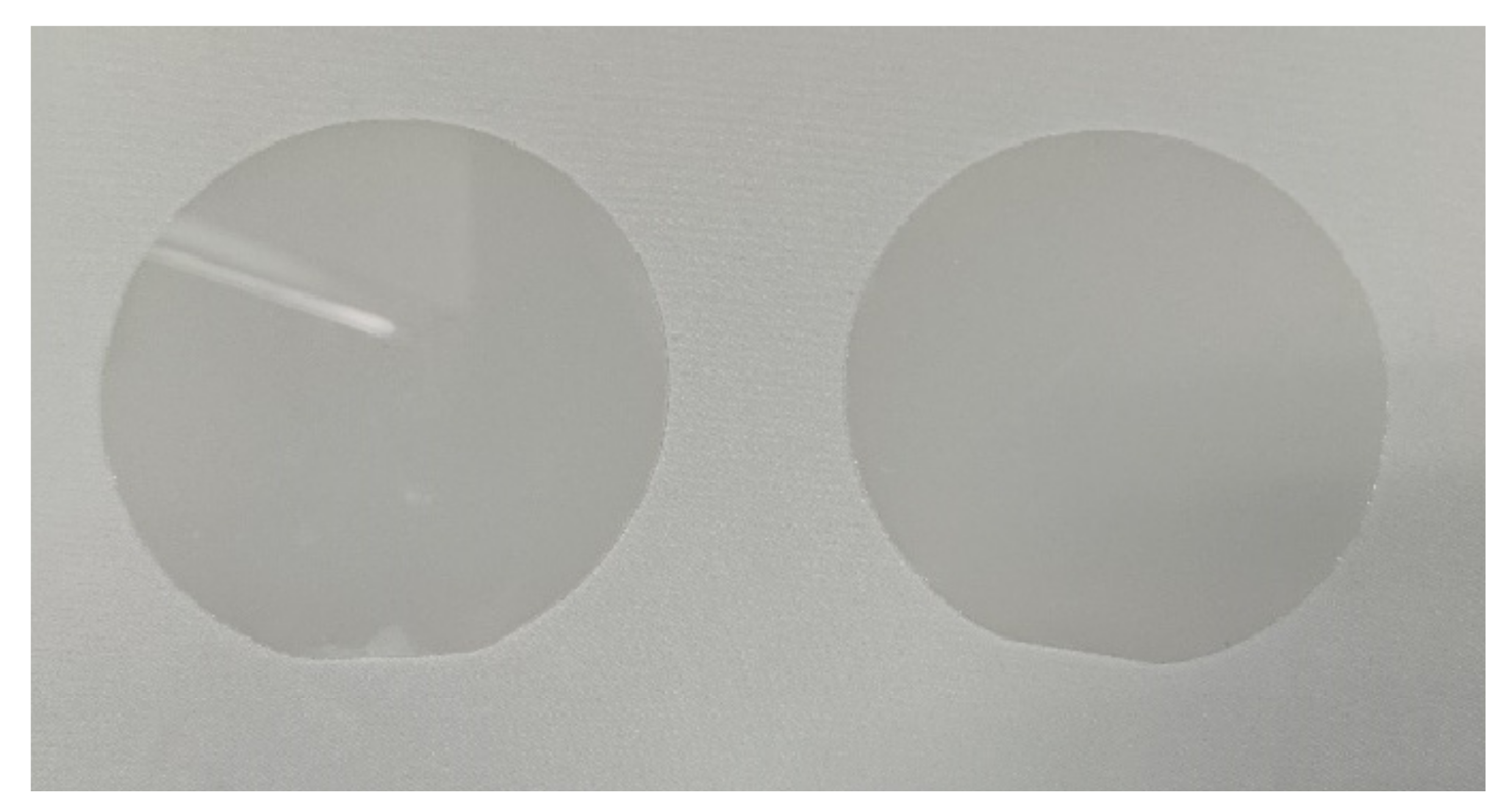
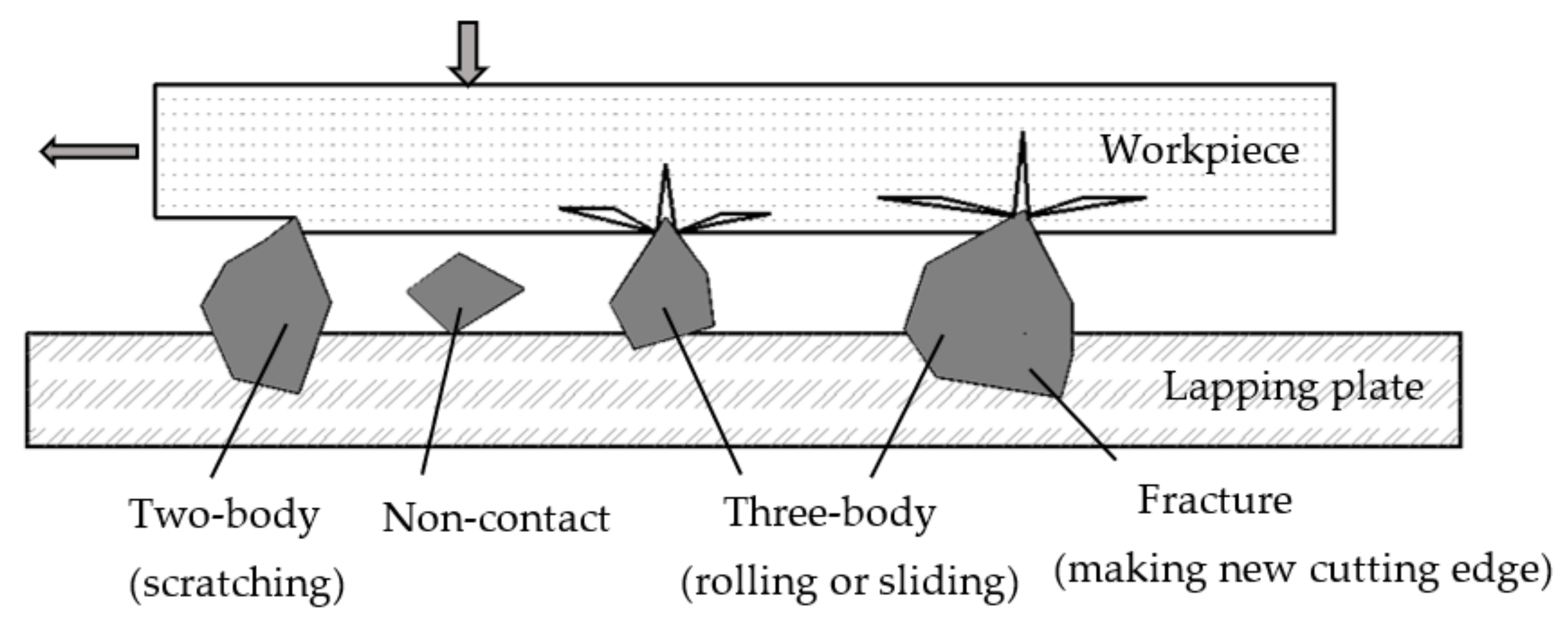
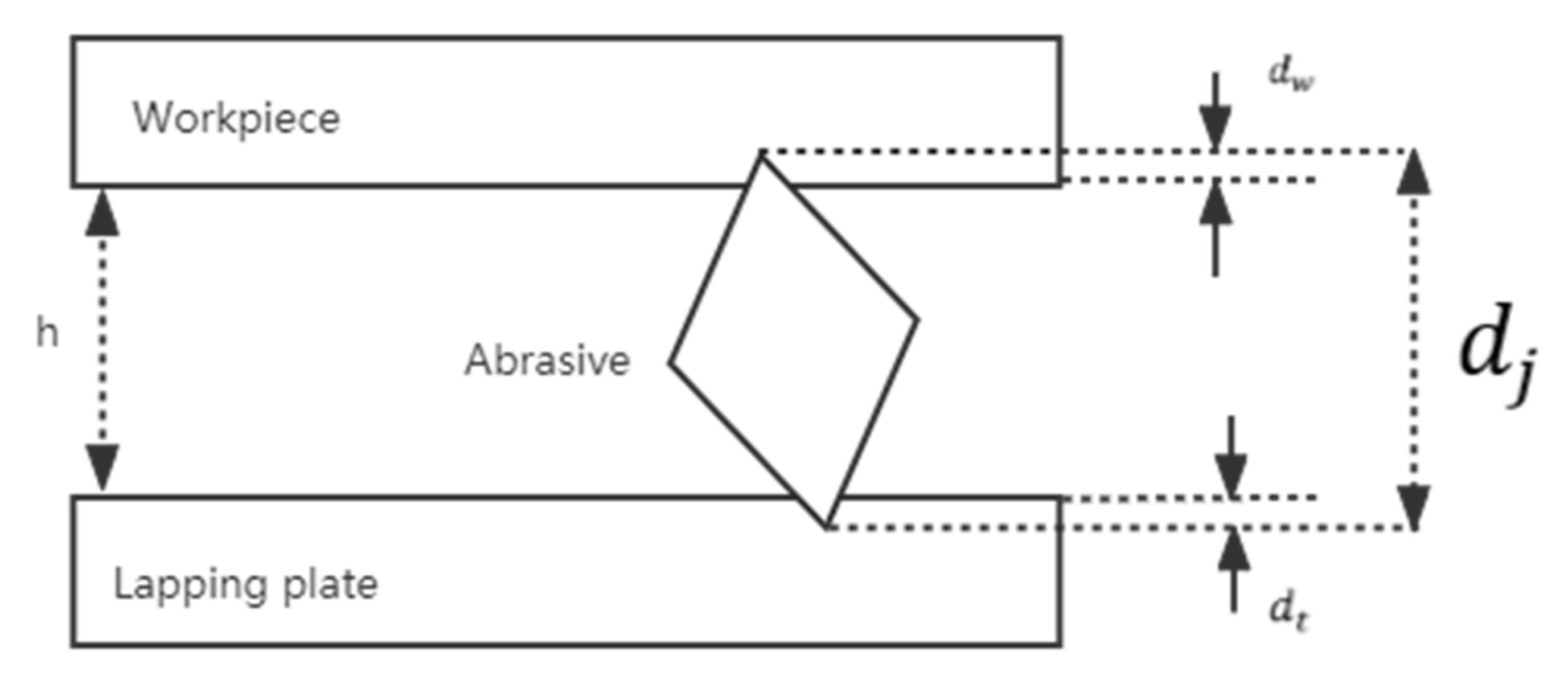
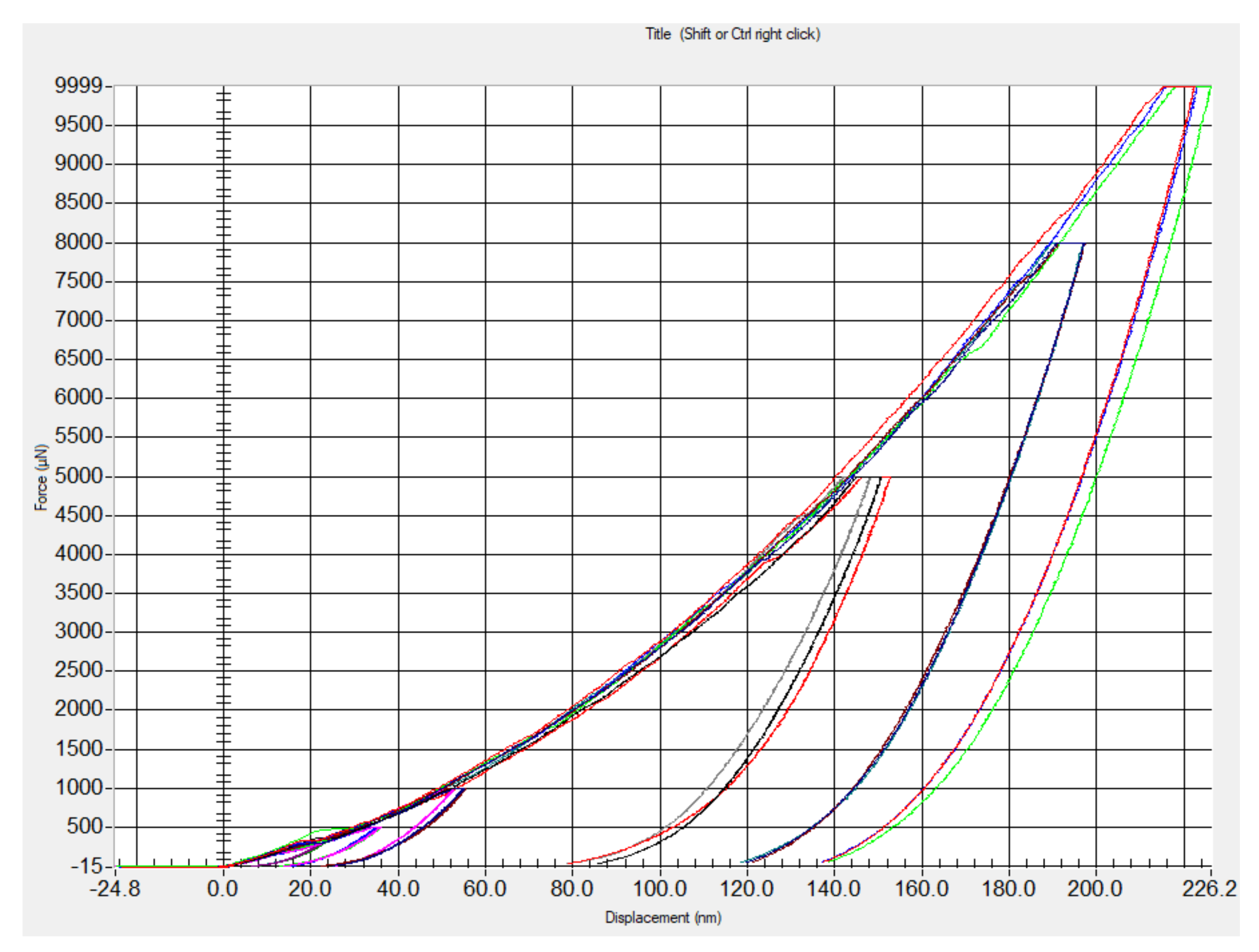


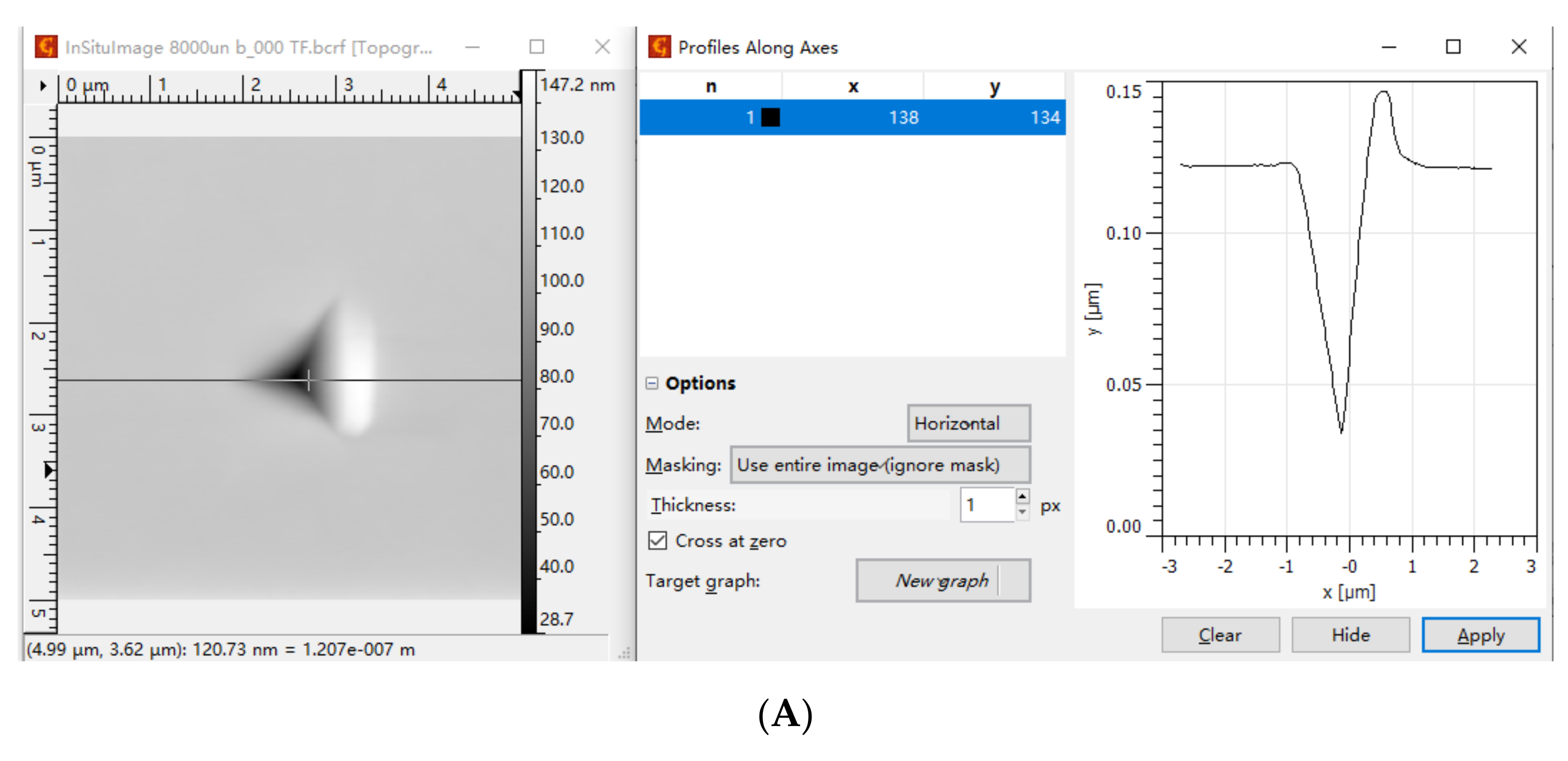
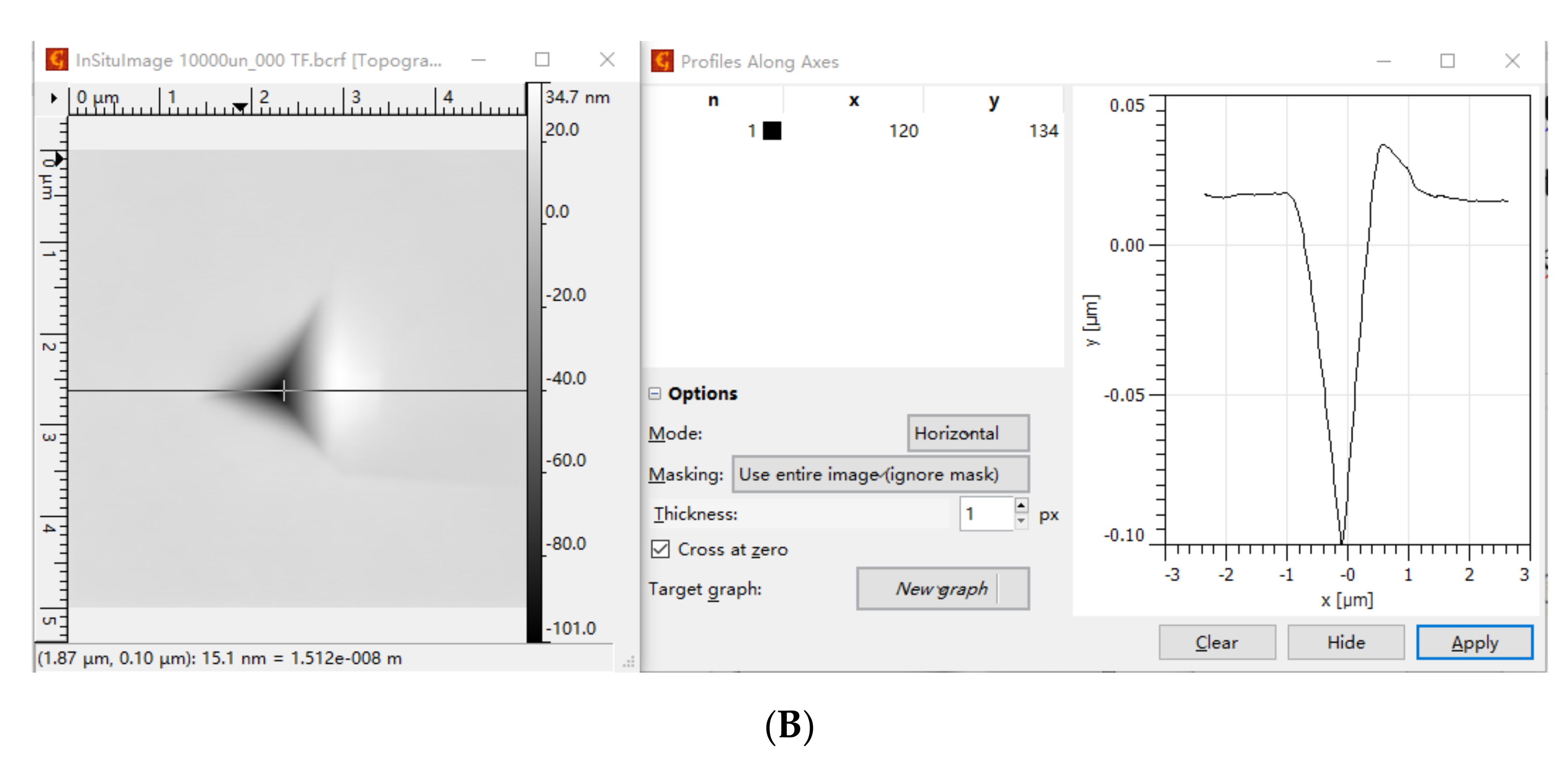
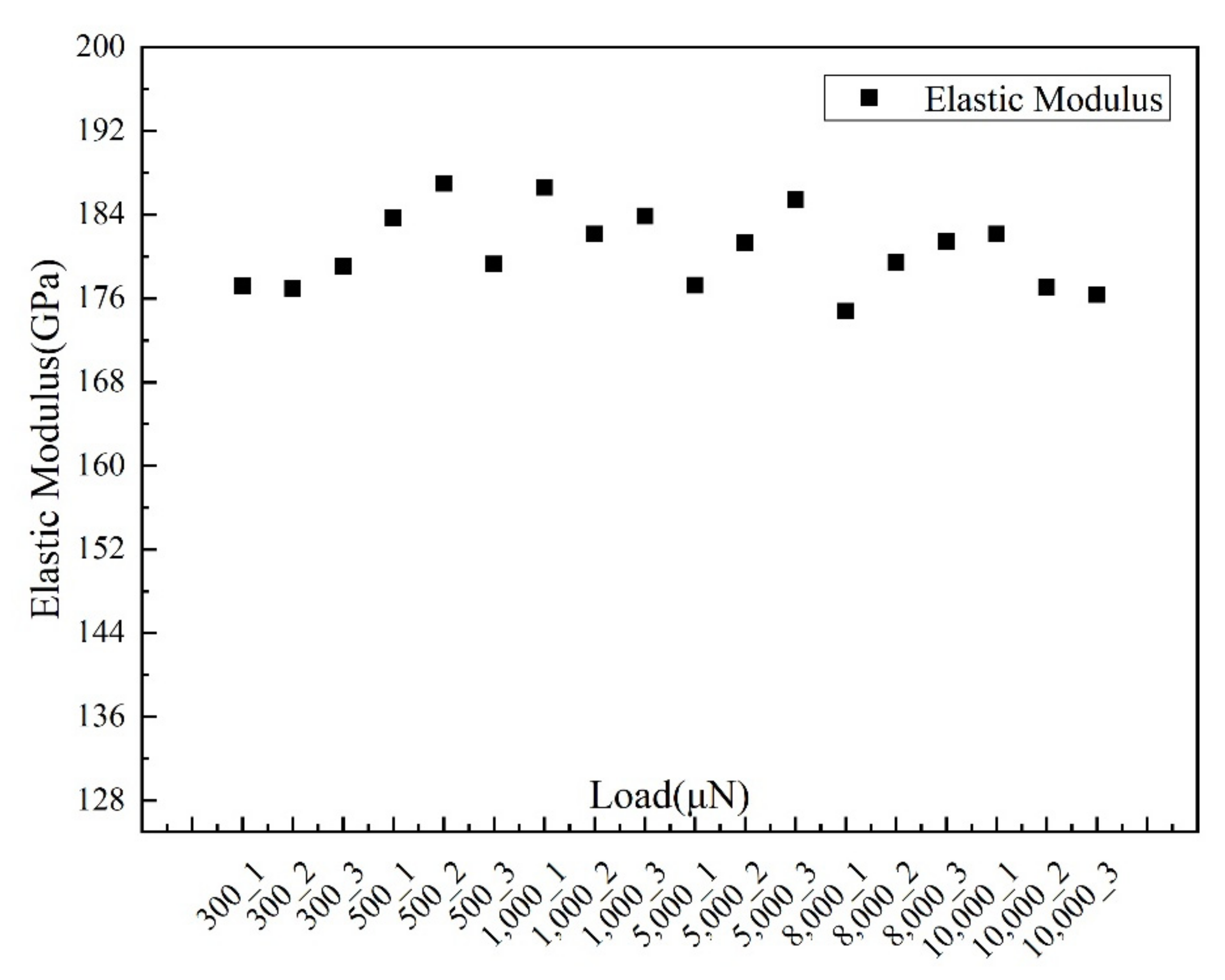


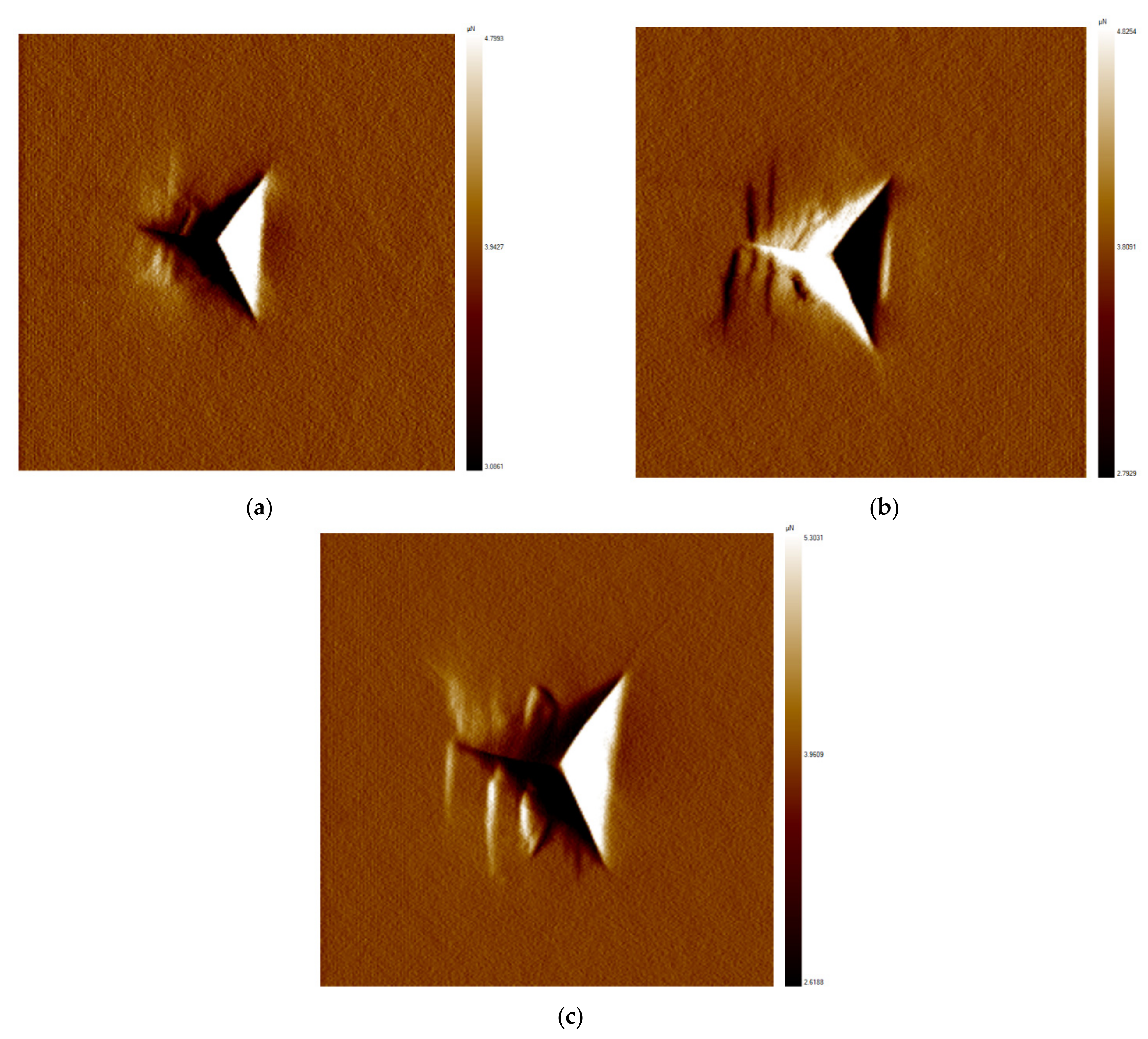
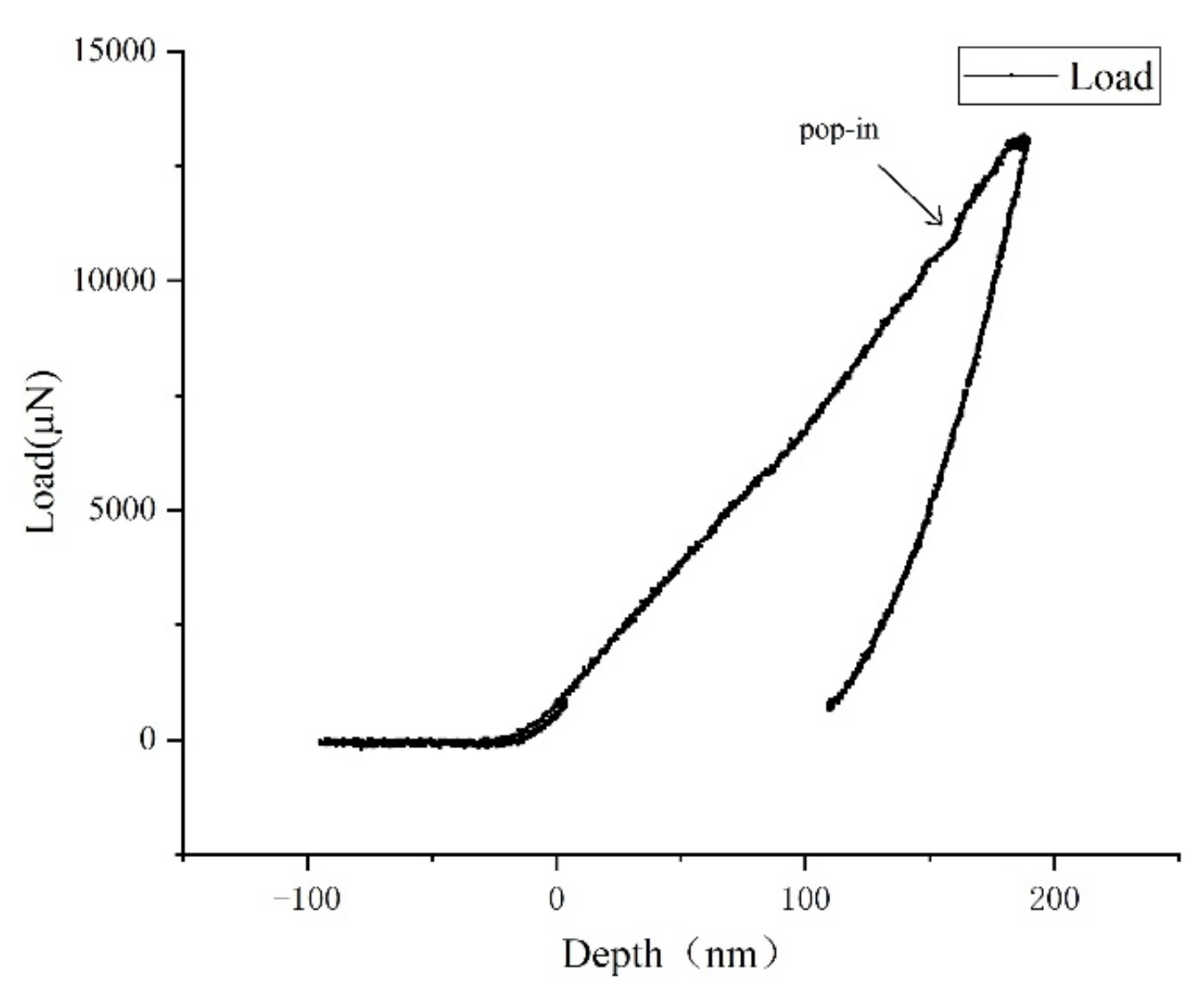



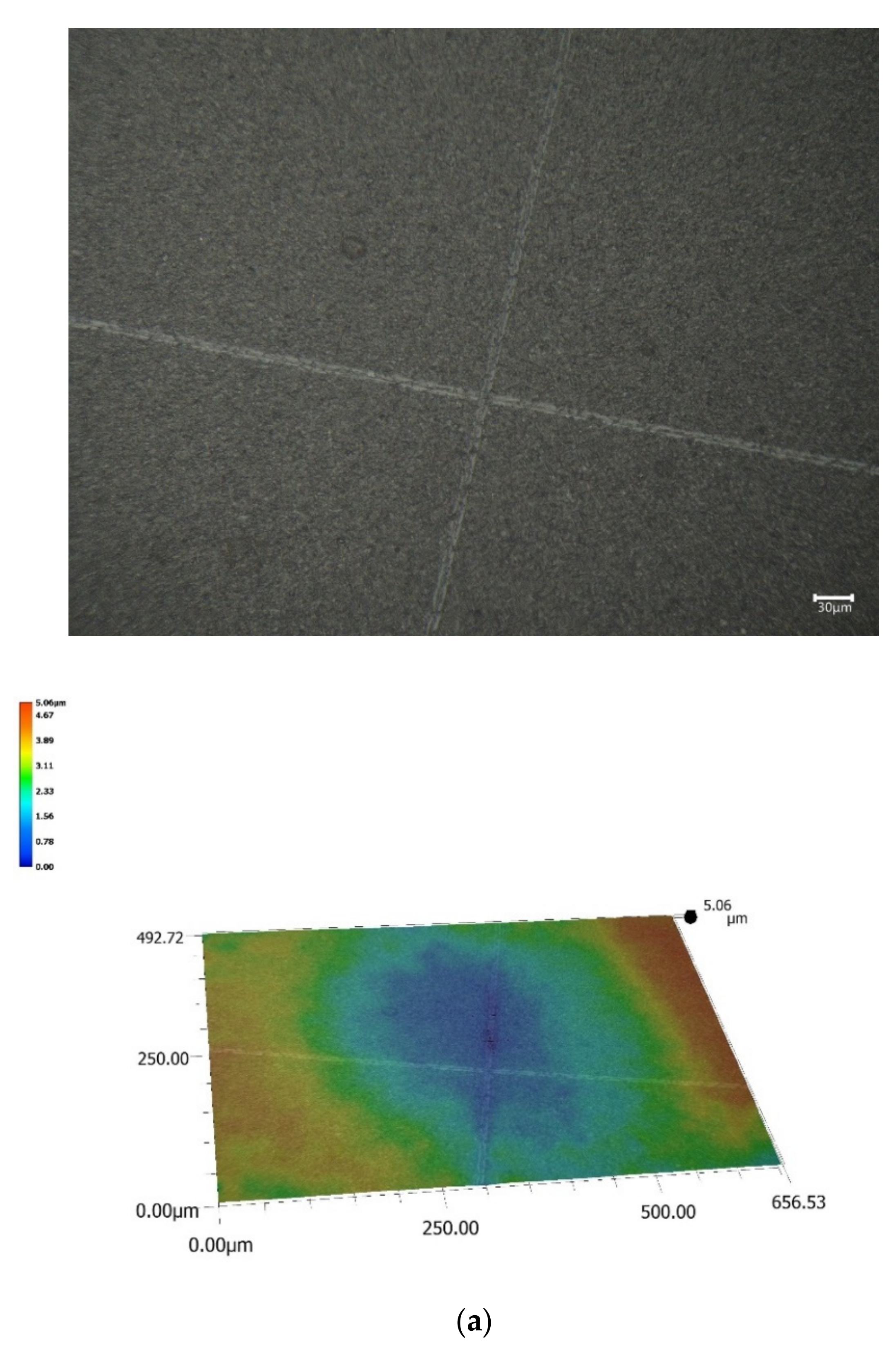
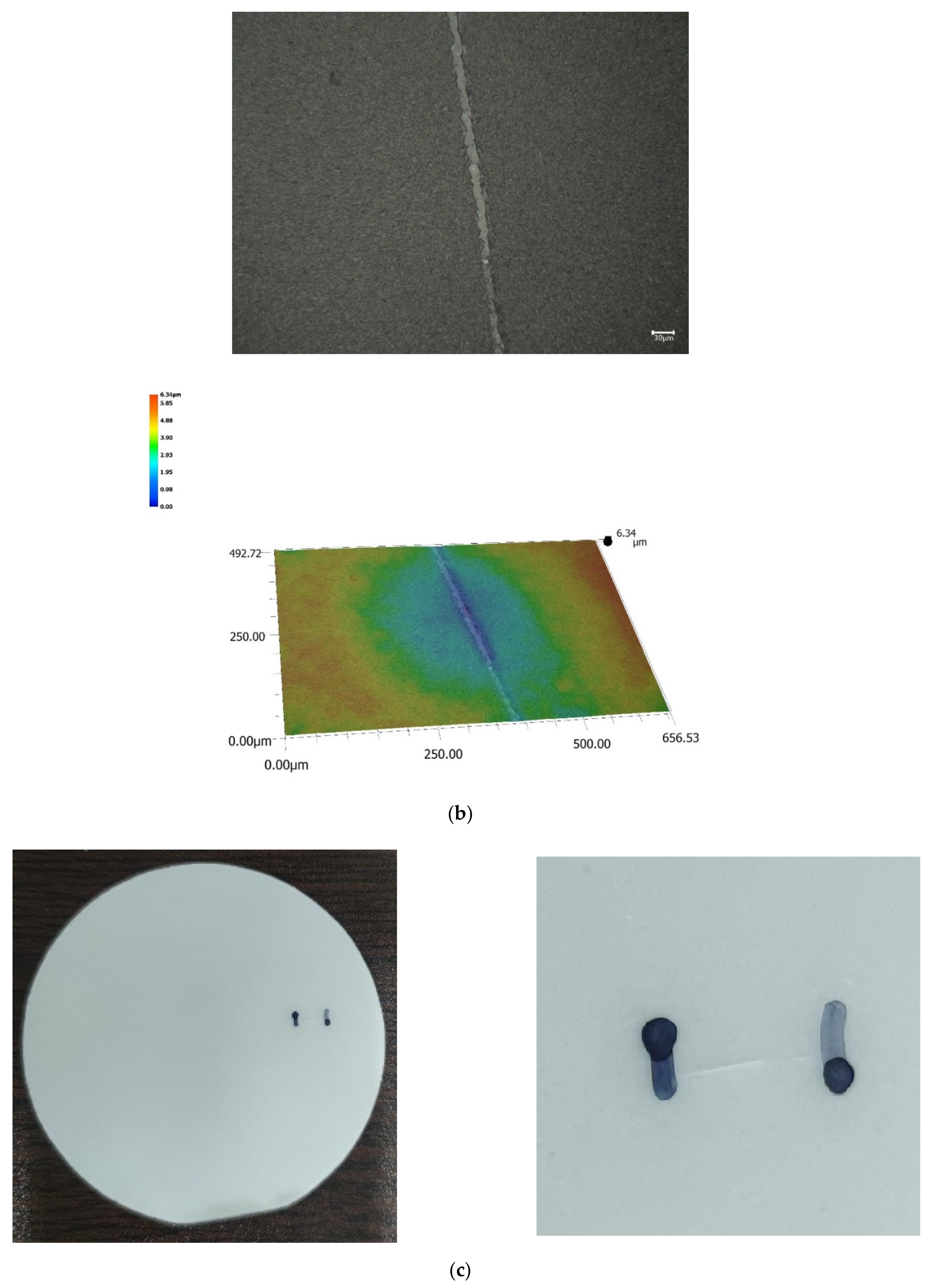
| Alumina Abrasive (Particle Size) | Average Value (μm) | Standard Deviation (μm) |
|---|---|---|
| W14 | 10.5 | 3.5 |
| W7 | 5.25 | 1.75 |
| W3.5 | 2.5 | 0.83 |
| W1.5 | 1.25 | 0.42 |
| Parameter | 1 | 2 | 3 | 4 | 5 |
|---|---|---|---|---|---|
| Load (kg) | 1.5 | 2 | 2.5 | 3.5 | 4 |
| Rotating speed (r/min) | 20 | 20 | 20 | 20 | 20 |
| Time (min) | 30 | 30 | 30 | 30 | 30 |
| Alumina Abrasive (Particle Size) | Total Number of Abrasive Particles (106) | Critical Load (N) |
|---|---|---|
| W14 | 41.34 | 9.63 |
| W7 | 165.38 | 19.23 |
| W3.5 | 729.28 | 39.92 |
| W1.5 | 2917.12 | 78.92 |
Publisher’s Note: MDPI stays neutral with regard to jurisdictional claims in published maps and institutional affiliations. |
© 2022 by the authors. Licensee MDPI, Basel, Switzerland. This article is an open access article distributed under the terms and conditions of the Creative Commons Attribution (CC BY) license (https://creativecommons.org/licenses/by/4.0/).
Share and Cite
Zheng, H.; Wen, D.; Kong, F.; Cai, D. Research on Critical Load of Lithium Niobate Crystal Lapping. Processes 2022, 10, 912. https://doi.org/10.3390/pr10050912
Zheng H, Wen D, Kong F, Cai D. Research on Critical Load of Lithium Niobate Crystal Lapping. Processes. 2022; 10(5):912. https://doi.org/10.3390/pr10050912
Chicago/Turabian StyleZheng, Hao, Donghui Wen, Fanzhi Kong, and Donghai Cai. 2022. "Research on Critical Load of Lithium Niobate Crystal Lapping" Processes 10, no. 5: 912. https://doi.org/10.3390/pr10050912
APA StyleZheng, H., Wen, D., Kong, F., & Cai, D. (2022). Research on Critical Load of Lithium Niobate Crystal Lapping. Processes, 10(5), 912. https://doi.org/10.3390/pr10050912




